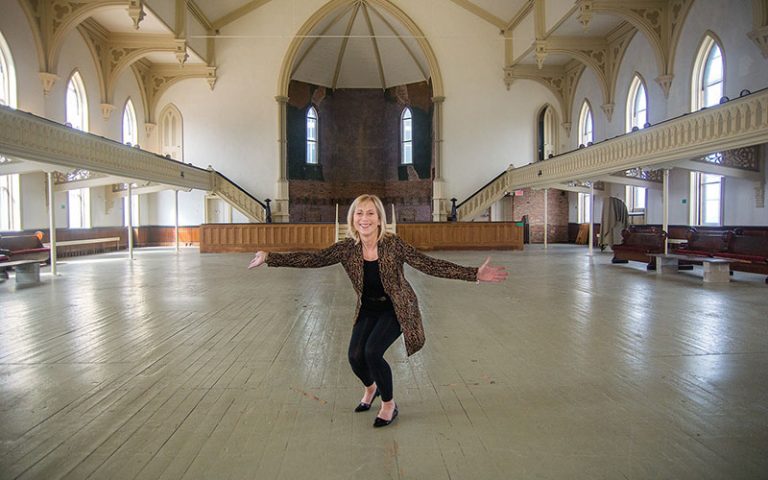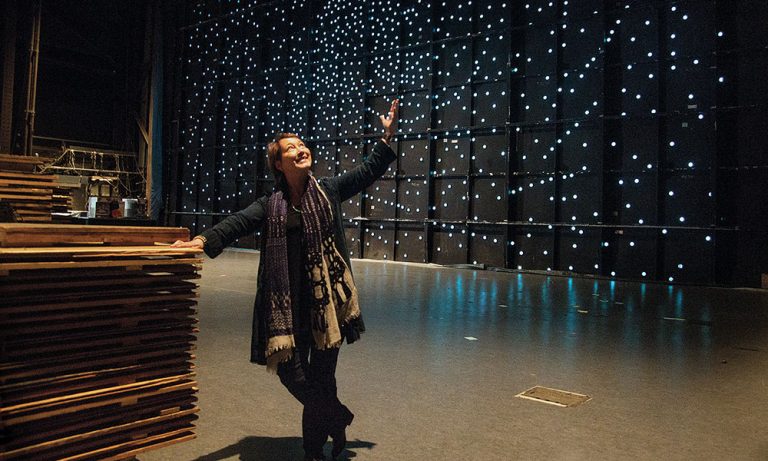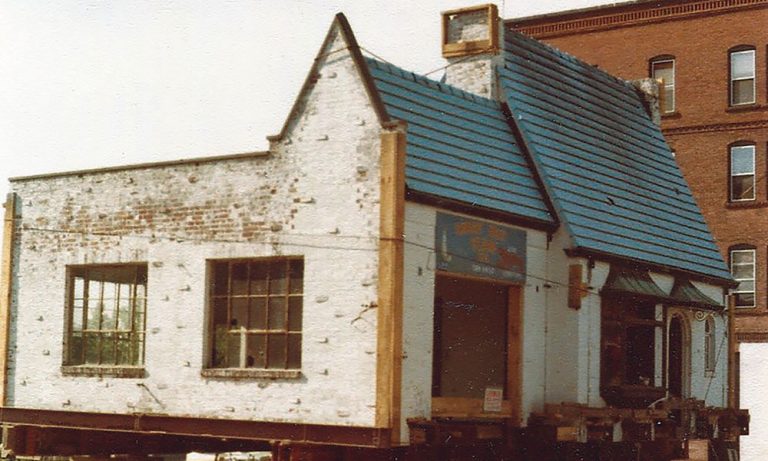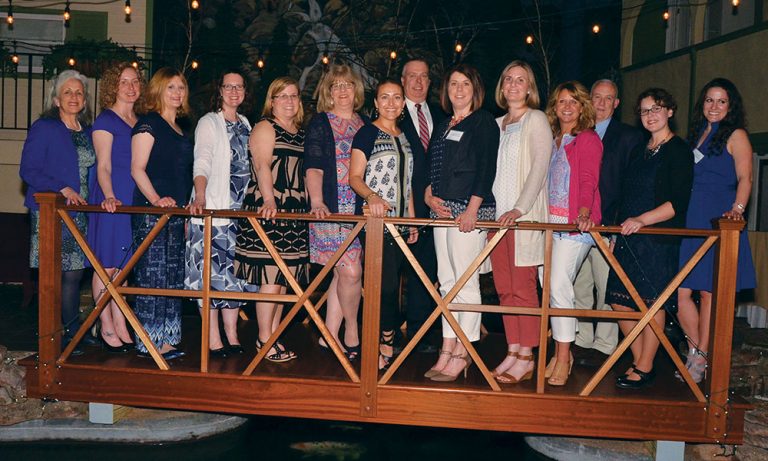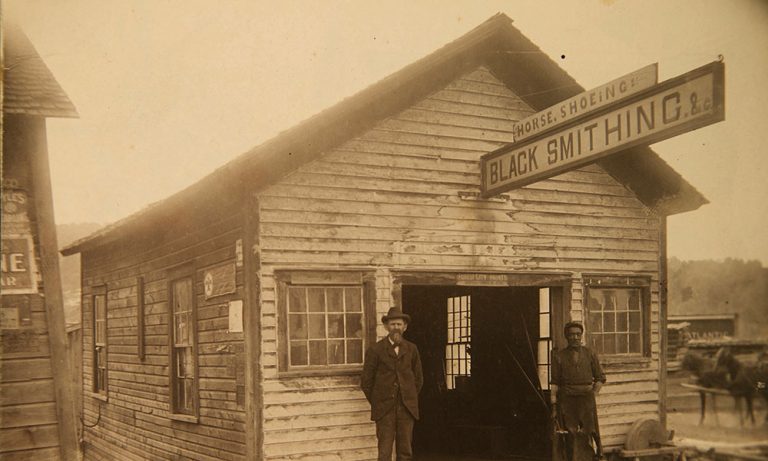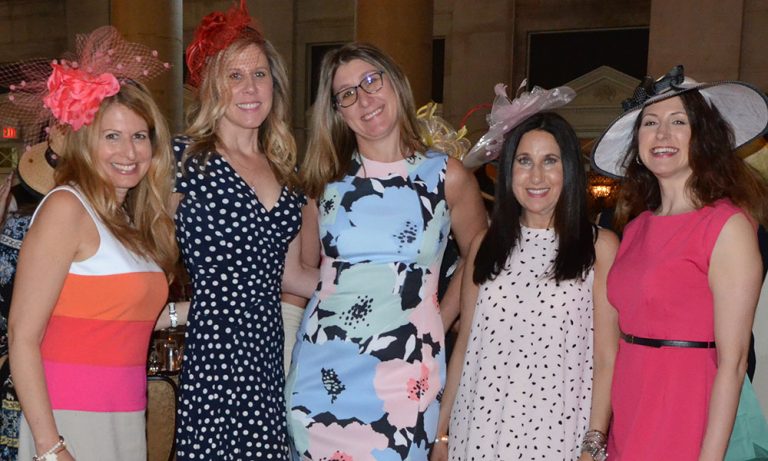The bell tower at the 146-year-old former Methodist Church on Washington Street is the tallest structure in Saratoga Springs, with a bell cast in Troy. Rescued from collapse in 1999, the building found new life as an arts center, but has floundered. Now, thanks to a collaboration with another Capital-Saratoga Region arts organization, it will not only survive, but thrive.
Health, history, horses… The arts have become the fourth jewel in the city’s crown, and are key players in the region’s economic growth. Many of the arts institutions in and around Saratoga Springs have women at the helm:
Sarah Craig at Caffè Lena, Elizabeth Sobol at SPAC, Elaina Richardson at Yaddo, Dorothy “Teddy” Foster at UPH, Michele Riggi at the National Museum of Dance, Erin Coe at The Hyde Collection.
Creative collaborations and initiatives have been central to their success.
Universal Preservation Hall was at a crossroads. The historic church had been saved from the wrecking ball, but efforts to transform the building into a downtown hub for the arts had stalled. Donations for the project had dwindled amid the recession economy, and the hall was struggling to find its niche among the city’s entertainment venues.
“There was no money coming, and we still had bills to pay,” recalls Teddy Foster, who was then president of the hall’s board of directors. “We were really hurting for money…I didn’t know what else to do and I didn’t want to close this building.”
Foster was also at a crossroads: Three years earlier, she had been laid off by Genworth Financial, a Fortune 500 insurance company where she had worked for more than a decade. Absent employment, she had embraced the plight of the hall as a full-time job—albeit unpaid.
By 2012, the hall was on the brink of insolvency, and Foster was prepared to think outside the box. She saw the success of Proctors Theatre in Schenectady and figured it couldn’t hurt to ask Philip Morris, the organization’s CEO, whether he’d be interested in forming a partnership.
“Come to find out they had already been talking about us,” she says. “From there, it was basically love at first sight.”
Of course, the collaboration didn’t happen overnight. However, following a pair of feasibility studies—one to determine usage of the facility, and the other to explore its avenues of financial support— Proctors agreed to manage the hall, while allowing it to maintain its own board of directors.
Today, Foster is campaign director of a $5.5 million effort to transform the hall into a 700-plus seat theater-in-the-round, complete with a state-of-the-art sound grid, lighting, and a retractable 30-foot screen. The project, which is expected to start this summer and finish in fall 2018, will also add an elevator, reconfigure a pair of staircases leading to the theater, and construct a modern glass atrium alongside the building to help with the flow of patrons.
After years of struggles, the hall is now on its way toward reaching its fundraising target. “Proctors hasn’t done anything in this building and they won’t until we’re done,” Foster said.
“But just knowing [they will] has helped us tremendously, especially from an awareness perspective.”
The collaboration between Universal Preservation Hall and Proctors mimics a pattern of success that other arts groups in the Capital-Saratoga Region have recognized—the mutual benefit of seeking partnerships within the arts community to grow their organization.
Several blocks away from the hall on Phila Street, Executive Director Sarah Craig is actively seeking partnerships to help draw attention to Caffè Lena. This spring, she partnered with Saratoga Performing Arts Center to host New York City’s St. Luke’s Chamber Ensemble at the café, a performance that touched off a six-part series at the coffeehouse that will extend into SPAC’s concert season. Caffè Lena is hosting performances at the newly-renovated Gazebo at SPAC this summer—a sign of the growing partnership between the two organizations.
Craig is also working with Foster to host an act displaced by the UPH renovation project. Caffè Lena will serve as the temporary home of the Rochmon Record Club, donating all proceeds from the program to the hall’s renovation.
“Our doors are wide open,” says Craig, “and our mission is to foster a healthy and creative community through music.”
At SPAC, first-year President and CEO Elizabeth Sobol views collaborations between the area’s arts organizations as a way to expand the scope and diversity of her organization’s programming. By fostering strong relationships with other nonprofits, Sobol believes SPAC can increase its cultural influence in the region and deepen its community connections, thereby solidifying Saratoga Spa State Park as a true haven for the Capital Region art scene.
“One of my key goals is to expand SPAC’s presence in the community through vibrant partnerships, which will not only enhance the breadth of our artistry, but connect us to new audiences,” she says.
Those partnerships include one with a neighbor in the Spa State Park—the National Museum of Dance and Hall of Fame. Once part of SPAC, the museum became an independent entity more than a decade ago, and has since developed its own unique identity under the guidance of Michele Riggi, president of the board of directors. Riggi has helped breathe new life into the organization by partnering with other organizations in the arts as well as within the community.
“This successful rise could not have been possible without the continual and unconditional support of our board president,” says Raul Martinez, director of the Dance Museum and its School of Arts, which offers classes in dance, theater arts and photography.
Collaboration has helped build the acclaim of The Hyde Collection in Glens Falls. Director Erin Coe has recognized the importance of collaborating with other arts organizations to expand the reach of the museum to audiences that may not have visited the gallery otherwise.
“In my experience, collaborations with other arts organizations are the key to The Hyde’s success and sustainability,” Coe says.
Yaddo, the 400-acre artists’ retreat in Saratoga Springs, also values collaboration. Yaddo President Elaina Richardson seeks partnerships within the arts community to help maintain its mission—to nurture the creative process by providing an opportunity for artists to work without interruption in a supportive environment.
“Here at Yaddo we’re doing all we can to offer that support to the world’s leading creative artists, and to bring the fruits of their labor to the widest audience possible—as we encourage dialogue, debate and engagement,” says Richardson.
Justin Mason is a Saratoga Springs-based freelance writer who escaped the clutches of daily newspaper journalism and now lives happily with his lovely wife, his beautiful daughters—two future leaders of the free world—and their dwarf tiger.
“We’ve gotten to where we are today by never saying no. We try to say yes to everybody.”
Teddy Foster, UPH
Dorothy “Teddy” Foster joined Universal Preservation Hall as a volunteer in 2006, became a board member, and spearheaded the organization’s fundraising efforts shortly thereafter. She was president of the board from 2009 to 2015. In 2015, she became the hall’s campaign director. As a result of a $5.5 million capital campaign, UPH’s main hall will be transformed into a 700-seat theater-in-the-round.
Initiatives:
Transforming the 146-year-old former Methodist church into a “hub for the creative economy” in downtown Saratoga Springs. Offering a wide breadth of programming, from music of all genres to children’s education.
Collaborations:
Schenectady-based Proctors Theatre will assist UPH with programming, ticketing, marketing, finance, and fundraising.
Promoting the arts in association with other area groups and venues, including Yaddo, Caffè Lena, Film Forum and Saratoga Artsfest, and, later this year, SPAC
Working with charitable organizations including Franklin Community Center, Shelters of Saratoga, Backstretch Workers and Racetrack Chaplaincy
—
“The rebirth of our historic performance space has made it clear that Caffè Lena is a thriving organization with an exciting future that will honor and build on its illustrious past.”
Sarah Craig, Caffè Lena
Sarah Craig was hired as the first executive director of Caffè Lena in 1995, about five years after the oldest continuously operating folk music venue in the U.S. became a non-profit organization. She began at Caffè Lena as a newly-married transplant from Boston, sharing both a similar background with its founder, Lena Spencer, and a desire to promote the creative community.
Initiatives:
Completing renovations to modernize the performance space, including broadcast infrastructure for performances. Continuing to evolve programming to reflect fresh trends in American roots music.
Collaborations:
Hosting off-site performances for Skidmore College’s Jazz Institute. Running a six-part series with SPAC. Bringing classical programming from the Luzerne Music Center.
—
“The board and staff of the National Museum of Dance work tirelessly to achieve its mission of fostering a true love and appreciation of dance and the arts both in our community and globally.”
Michele Riggi, National Museum of Dance
Michele Riggi has been president of the board of directors at the National Museum of Dance since 2006. A prolific philanthropist, Riggi also spearheads fundraisers for organizations that support animal rights and welfare.
Initiatives:
Continued growth of the School of the Arts, which teaches dance, music, acting, photography, and more to over 400 students each week. The Dancing Athlete exhibit welcomes school and semi-pro sports teams who tour the museum and take a movement class to improve performance on the playing field. Interactive technologies and programming. Promote the museum as a hub for fundraisers and benefits for other not-for-profit organizations.
Collaborations:
New York State Summer School of the Arts, Creative Place International, SPAC, Adirondack Shakespeare Company, Opera Saratoga, and more.
—
“With such an abundance of cultural organizations here in Saratoga, the possibilities for collaboration are virtually endless.”
Elizabeth Sobol, SPAC
Elizabeth Sobol was named president and CEO of the Saratoga Performing Arts Center in October 2016, bringing to the venue decades of artist management and recording industry experience — both in the classic arts and mainstream entertainment.
Initiatives:
“SPAC on Stage,” a new series debuting in August that will challenge concert hall convention by placing the audience onstage with the artists.
Collaborations:
Presenting a summer series of concerts with Caffè Lena to take place at both venues. Featuring acclaimed pianist Simone Dinnerstein and the Havana Lyceum Orchestra at Skidmore College’s Zankel Music Center.
—
“By partnering and sharing resources, expertise, and visibility, we are stronger than when we try to go it alone.”
Erin Coe, The Hyde Collection
Erin Coe became director of The Hyde Collection in Glens Falls in 2015, following 15 years as the museum’s chief curator. Under her leadership, The Hyde undertook a renovation that added a new admission area and the Whitney-Renz Gallery, and upgraded its technology. She supervised the restoration of the Hyde House — the former home of founders Louis and Charlotte Hyde.
Initiatives:
Having secured a major gift of postwar Modern art, implementing plans for an additional gallery for the exhibition of Modern and Contemporary art to open in June. Increasing the museum’s accessibility, community engagement, and visitor experience.
Collaborations:
“Friendships of Arcadia” with Yaddo, 2001; “Season of Degas” with SPAC, 2009. Hosted Charles Evans Hughes Day, a city-wide celebration of the Glens Falls native and American statesman, 2016. Presented In the Spirit of the Firebird with Glens Falls Symphony Orchestra, a film and discussion on Stravinsky’s art, in May. Lecture on Georgia O’Keeffe at Wiawaka Center for Women, a collaborator with Adirondack Theatre Festival for “Modern Nature: Georgia O’Keeffe and Lake George,” in 2013.
—
“The power of art and literature to help us make sense of our world has never been more evident or more urgently in need of support.”
Elaina Richardson, Yaddo
Elaina Richardson joined Yaddo in 2000 after a decade as editor-in-chief of Elle. She has overseen a dramatic transformation of the National Historic Landmark property, including the construction of seven new studios and a campaign to preserve the storied mansion. Under her tenure, the number of applicants has risen to an all-time high. Originally from Glasgow, she was educated at the University of Edinburgh and Oxford University.
Initiatives:
Campaign to “Preserve our Past and Build a Vibrant Future,” which has raised more than $6 million to ensure Yaddo remains a pre-eminent artist retreat.
Collaborations:
Artist readings at Northshire Bookstore, UPH, and Congregation Shaara Tfille. A new Young Archivists group at Saratoga High School doing research at Yaddo and New York Public Library. Programs in Washington, D.C. with the German Embassy and New York University-DC. —Justin Mason



